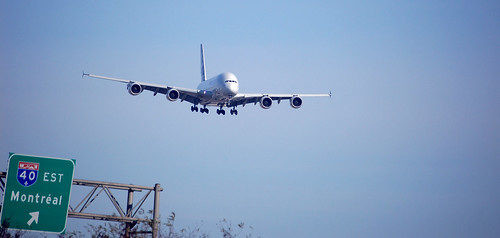Everybody’s talking about the Airbus A380 that landed at Montreal’s Pierre Elliot Trudeau airport yesterday. I’m a big fan of airplanes and flying, so I wish I could have been there to witness it. I’m an uneasy fan, however, as I realize that air travel is one of the biggest contributors to pollution, oil consumption, and greenhouse gases.

Photo by Abdou.W (via Flickr) |
The A380 is supposed to be more fuel efficient than other jumbo jets, which is encouraging. The plane is also supposed to be significantly quieter than other large passenger planes, an improvement which should not be overlooked. But what do all those numbers really mean? I decided to do some calculations in order to find out.
Fuel Consumption
The A380 supposedly uses “less than three litres of fuel, per passenger, per 100 kilometers.” Apparently that’s pretty efficient for a big jumbo jet, at least on a per-person basis. Airbus’s Web site claims it is 17% more efficient than “today’s largest aircraft.” (Elsewhere on the site it says the plane “burns 12 per cent less fuel per seat” than “its competitor.”)
Those “per person” numbers look impressive, but what happens when you start factoring in many persons and long distances? For example, Montreal to Paris is something like 5500 kilometres. The standard configuration for the plane is for 525 passengers in three classes. (It can carry up to 853 people, but that assumes an “all economy” configuration – which is unlikely to occur. )
Since the 525 seat configuration is mentioned on the Airbus Web site “green” pages, we’ll use that as our basis. In that case, 525 people times 5500 kilometres equals 2,887,500 “person-kilometers” for the trip. Divide that by 100 and you get 28,875 “100-kilometer units,” multiplied by 2.9 liters per unit (“less than three litres”), and you get a total of 83,737 litres of fuel burned for one trip across the pond.
CO2 Emissions
Airbus’s Web site says the A380 emits 75 grams of CO2 per passenger, per kilometer. So let’s crunch some numbers again, using the same Montreal-Paris flight we talked about above.
525 passengers times 5500 kilometres times 75 grams = 216,562,500 grams, or 216,562 kilograms, or almost 217 metric tonnes of CO2 for that one flight to Paris.
Let’s put that in perspective. According to the calculator at the U.K.’s Society of Motor Manufacturers and Traders Limited’s Web site, my Honda Fit spits out 134 grams of CO2 per kilometer, which is almost double that of the (per passenger) output of the A380. So having 525 people fly to Paris on an Airbus A380 is like having 294 people drive there in Honda Fits (assuming you could drive across the ocean).
Keep in mind, however, that this Guardian Travelog story calls some of those numbers into dispute. For example, it claims the efficiency numbers are based on 550 passengers with no baggage or cargo.
Conclusions?
I have to admit, I thought air travel burned more fuel and emitted more pollution than what these numbers indicate. I feel less guilty about my once or twice a year plane rides now. But all you have to do is watch the dozens of planes that land at Montreal’s airport every hour, or the roughly 1500 landings and takeoffs per day at Charles de Gaulle International Airport to realize how many planes are out there spewing their 75, or 90, or 150 grams of CO2 per passenger per kilometer. Even if flying is more fuel and emissions efficient than driving, there is still a “death by a thousand cuts” issue based on the sheer volume of daily air traffic.